Since I last called for caution on the iShares MSCI Hong Kong ETF (NYSEARCA:EWH), the fund has further underwhelmed – and for good reason. For all the recent investor concerns about the state of property in mainland China, Hong Kong is having it much, much worse. Hong Kong’s monetary policy is tied to an exchange rate peg, which means the double shock from ‘higher for longer’ policy rates in the US and rapidly increasing Treasury yields (particularly at the long end) is directly flowing through to its economy. Unlike the US, though, the Hong Kong economy (low inflation/low growth) isn’t at all equipped to deal with this level of tightening.
With no room to maneuver on the monetary policy side, the government has stepped up with some incremental fiscal measures. These will help at the margin, along with a post-COVID rebound in mainland Chinese visitors. But EWH’s heavy gearing toward rate-sensitive sectors means its large-cap portfolio will need to weather some significant headwinds from here. Despite returning to pre-reopening levels, the EWH portfolio isn’t priced all that cheaply either at ~15x earnings (vs. low-single-digits % consensus earnings growth this year). Net, I would remain on the sidelines into 2024.
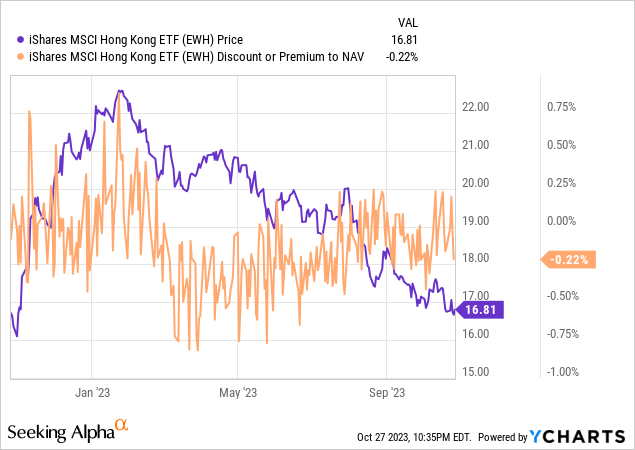
Fund Overview – An Increasingly Concentrated Hong Kong Blue Chip Portfolio
The iShares MSCI Hong Kong ETF tracks (pre-expenses) the MSCI Hong Kong 25/50 Index, a basket of Hong Kong large-caps with two key constraints – <25% of assets invested in a single issuer and <50% cumulative allocation for all stocks with a >5% weighting. EWH has seen its net asset base erode further to $579m over the last quarter, while its expense ratio remains at 0.5%, a 40bps premium to Franklin Templeton’s FTSE Hong Kong ETF (FLHK). Both funds retain similar compositions, though FLHK imposes stricter weightage caps. EWH makes up for its premium fee structure and relatively higher concentration, however, with better liquidity and a longer track record.
iShares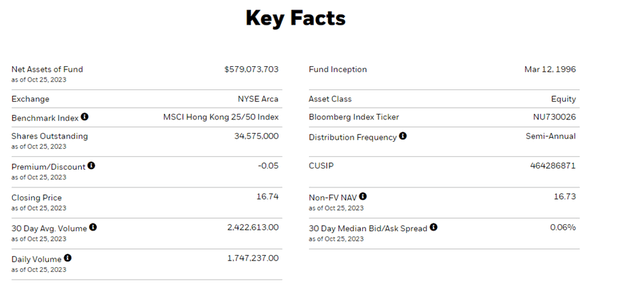
The sector allocation remains skewed toward financials (banking and insurance) and real estate (including development and management). The key allocation change over the last quarter is the shift toward insurance, the largest sector weighting at 23.5%, amid tailwinds from China-related sales. In contrast, real estate has ceded portfolio share on the back of the sector’s mounting headwinds, with the management & development sector down to 18.6%. In total, the aggregate financials and real estate allocations now stand at a cumulative ~68% (excluding the real estate holdings at listed conglomerates), about nine % points above key comparable FLHK.
iShares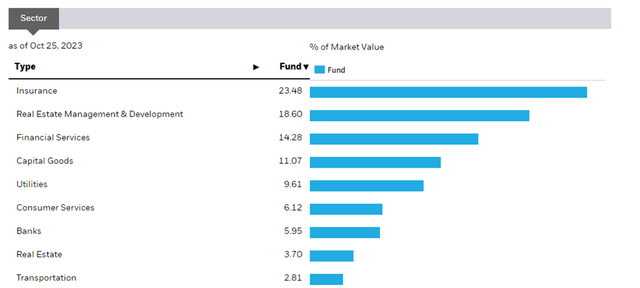
Insurer AIA Group (OTCPK:AAGIY) now leads the 33-stock EWH portfolio allocation by a wider margin at 23.5%. In comparison, exchange and clearing house operator Hong Kong Exchanges and Clearing Limited (OTCPK:HKXCY) remains largely unchanged at 12.7% of the portfolio. Hotel and casino operator Galaxy Entertainment (OTCPK:GXYEF) has fallen out of the top-five list, ceding portfolio share to conglomerate CK Hutchison (OTCPK:CKHUY) and power equipment manufacturer Techtronic Industries (OTCQX:TTNDY). The portfolio composition is in line with FLHK, though the latter’s stricter weightage caps and broader portfolio (now at 79 holdings) means EWH is the more concentrated option.
iShares
Fund Performance – Headed for One of the Worst Years on Record
EWH has seen steep declines in recent months amid intensifying worries about Hong Kong’s links to a slowing Chinese economy and rising rates in the US (imported via the HKD’s peg). As a result, the fund is now experiencing one of its worst years on record at -19% YTD, well below even the COVID-impacted years. While the fund still retains a respectable longer-term track record (+4% annualized since inception), this is mainly a result of strong capital appreciation in its early years. Over three and five-year timeframes, on the other hand, EWH investors have realized -5% and -4% annualized declines, respectively, reflecting the maturity of the Hong Kong market.
iShares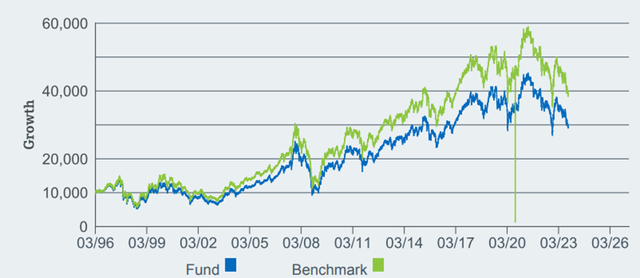
Despite EWH’s recent drawdown, its portfolio still doesn’t screen cheaply at 14.8x P/E (one turn above FLHK). The fund may be priced below book (~0.8x P/Book), but book value discounts are the norm for Hong Kong property/banking stocks, many of which are assigned conglomerate discounts and have earned below their cost of capital for years now. Perhaps more importantly, the market may be pricing in even more downward earnings revisions – note that October saw some of the steepest earnings resets since COVID.
Yardeni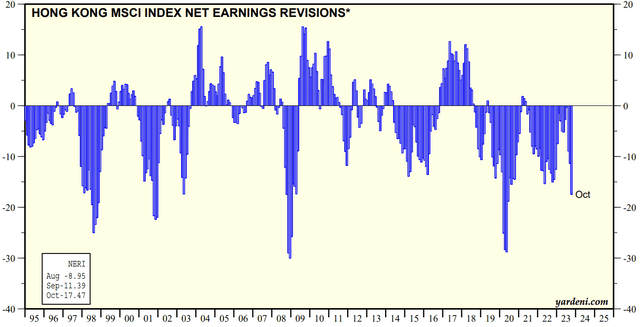
As appealing as the portfolio’s defensiveness (0.48 equity beta) and distribution (~4% 30-day SEC yield) might seem to the income-oriented, I would be very cautious about buying this dip anytime soon.
Morningstar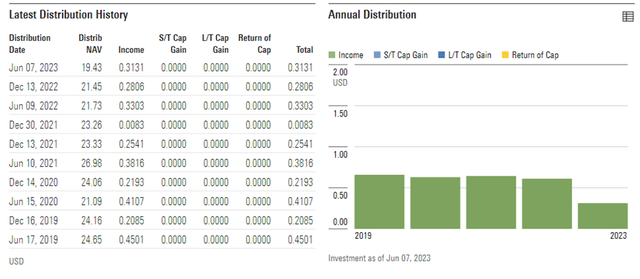
An Untimely Tightening Shock
Hong Kong’s consumer inflation is currently running at <2%, which would be good news if the region weren’t at risk of demand-driven deflationary pressures from mainland China. Alongside the China shortfall, continued tightening in the US, imported via the HKD peg, is a big overhang on the property market. Note that new mortgage interest rates have exceeded the 4% threshold but have yet to fully reprice in accordance with long-duration US Treasuries (currently ~5%).
As mortgages in Hong Kong have risen to almost 70% of household debt, with insufficient wage growth to match, even small rate increases could have a large impact on disposable income demand. Plus, there are knock-on impacts to consider. Firstly, from negative wealth effects but also from higher risk premia on bank lending translating into higher rates. The latter could worsen should more households fall into negative equity positions, further weighing on the broader economic slowdown.
Fed
Corporates are set to be impacted quite heavily as well, especially those in rate-sensitive sectors like property and financials (EWH’s key sector allocations). Thus far, the full impact of higher rates has yet to be felt, with USD bond issuance out of Hong Kong drying up this year in reaction to escalating treasury yields. Companies will have to re-lever eventually, though, and when they do, much higher debt financing costs are in the offing.
First in the line of fire are developers (e.g., key EWH holding Sun Hung Kai Properties) with a high % of floating rate debt. Then comes the banks, many of which will see lower credit demand in line with a weaker macro while also increasing bad debt provisions as property prices decline. With Hong Kong bank loans already contracting (down 5% YoY) and likely to trend lower until Treasury rates ease, the vicious selloff in Hong Kong equities is probably warranted.
TradingEconomics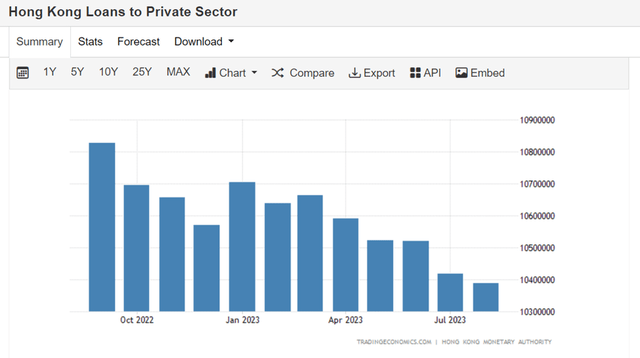
Hong Kong is Catching a Cold
Hong Kong’s long-held policy of keeping its currency ‘linked’ to the US dollar is starting to reverberate through its economy – for the worse. The key issue is the Fed’s ‘higher for longer’ prescription (imported via the HKD peg) being completely at odds with Hong Kong’s current <2% inflation backdrop, as well as its underlying growth fragilities.
Large caps in Hong Kong are also highly rate-sensitive, given their property/financials-heavy mix and relatively high gearing levels. Benefits from China’s post-COVID reopening are flowing through to the economy, though nowhere near the pace required to offset the knock-on impacts from a property/financing crunch.
So, while dividend yields are appealing (~4% for EWH and closer to ~6% for Hong Kong property), it’s largely down to a higher risk of payouts being cut vs earnings growth. The current mid-teens earnings multiple isn’t cheap either relative to a low-single-digits % growth algorithm this year. On balance, I would remain sidelined here.
Read the full article here



